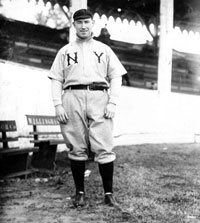|
Years the League Operated 1915
1916
1917
1918
1920
Standings and League Leaders |
Class D, Blue Ridge League - Chapter 3
As the United States was preparing itself to enter the
great conflict over in Europe, baseball was taking on a
new meaning to the players and fans throughout the
country. With a countrywide armed services draft looming
in the near future, many communities rallied around
their war efforts, forcing many baseball leagues hard
pressed to find good baseball players and umpires to
play baseball during this season.
Blue Ridge League Among Two Class D Leagues to Finish
Season
When the 1917 baseball season began, eight Class D leagues began play. However, by May 30, the once stable North Carolina State and Georgia-Alabama Leagues had disbanded because league clubs could neither field full teams or were losing money due to the lack of attendance at their ballparks. On June 6, the Central Texas League followed, and by July 4, the Dixie and Northern Leagues were no longer in existence. The Central Association received permission to shorten their season on August 7, leaving on the Western Association and the Blue Ridge League as the only two remaining Class D leagues to complete their regular seasons as scheduled.
The exodus was evident through out professional
baseball. None of the Class C leagues completed their
seasons, and only the Major Leagues and Class AA leagues
went unscathed.
The Class D, Blue Ridge League survived, thanks to the consistent leadership of League President, James Vincent Jamison, Jr. Despite many uphill battles throughout the season, the league prospered despite the adverse conditions. Chambersburg Too Big For Their Britches?
Coming off their first league championship in 1916, the
Chambersburg club started off the season with a brash
air of confidence that irked the rest of the league,
sparking controversy within the league during the early
part of the 1917 season. Prior to the season, each club
was required to pay a non-refundable $450 forfeit fee to
the league. The Chambersburg directors, led by a man
named Kottcamp, refused to pay this fee, stating the fee
was too expensive, and they would not pay it, earning
them the ire of President Jamison, and the other league
directors.
Injuries and Controversy Plague Maroons
As fate would have it, the Chambersburg was beset with
many injuries, highlighted by their star player, first
baseman Karl Kolseth. Kolseth, the most feared hitter in
the league at the time, broke his leg sliding into
second base during the first week of the season, and was
out for the remainder of the season. Internal problems
also plagued the Chambersburg club, as Manager Eddie
Hooper and his players were at odds with the club
directors, some fans, and one of the local newspapers.
A Major Challenge for the League President
The Gettysburg club, which was having severe financial
difficulties, also did not pay their forfeit fee prior
to the start of the season. These challenges proved to
be the biggest test in Jamison’s presidency of the
league, and he held steadfast. In the meantime, Colonel
Russler and representatives from Cumberland, MD made a
request to enter the league. The Colts, as they were
called, played in the now-defunct Potomac League in
1916, and had kept their club intact, playing an
independent schedule.
Jamison continued to request Chambersburg to remit the
full forfeit fee to the league, and issued a dated
ultimatum to the Chambersburg directors by June 30. If
they failed to comply, he would take their franchise
from them, and give it to another club that requested to
enter the league.
Move West Young Man … to Cumberland
Jamison made good on his promise, and instructed the
Colonel Russler of the Cumberland club to take over the
Chambersburg franchise effective immediately. Despite
the protests of the Chambersburg directors, Maroons
Manager Eddie Hooper and his players played their last
game in Chambersburg on June 30. The team packed up
their bags, and headed west to Allegany County,
Maryland. Playing two days on the road, the
disenfranchised club played with no nickname, until they
arrived in Cumberland for the first time and played as
the “Cumberland Colts”.
Hooper, who was also the league’s best player during the
league championship season the year before, did not like
the situation his club was facing, and refused to report
when the club had their first home game in Cumberland a
few days later. Hooper resigned as Manager, and was
replaced by veteran player/manager, Brook Crist. This
did not sit well with some of his former players, and by
the team played in Cumberland, only a few players
remained from the club that started the season in
Chambersburg..
Sunday Baseball Comes to the Blue Ridge League
The six original Blue Ridge League towns each had their
own Sunday Blue Laws, prohibiting play of any sporting
activities that required a ticket for admission on
Sundays. Up until Cumberland admission to the league,
games were played between Monday through Saturday, with
a day off on Sunday.
Allegany County, MD did not have the Sunday Blue Laws that the other counties or townships in the league had, and the Cumberland club was known for drawing large crowds to see the Colts play on Sunday. Despite some protests from a few of the league clubs, Cumberland scheduled to play games on Sundays. Cumberland defeated visiting Hanover, 5-4 in the first ever Sunday game played in the Class D, Blue Ridge League. However, Gettysburg and Hagerstown, refused to play any games on Sunday.
A Few Bumps In The Road
The addition of Cumberland into the league caused many
logistical problems for some of the teams, especially
the clubs in Gettysburg and Hanover, PA, which was the
eastern most towns in the league. When the Ponies drove
to for the their first road trip to Cumberland, the trip
took almost eight hours through the hilly, mountainous
terrain. By the time the Gettysburg team arrived in
Cumberland, it was two hours after their game was
scheduled to play, almost causing them to forfeit. After
an agreement, the two clubs played a double header the
next day, but after the Gettysburg club returned home,
their club directors complained to Jamison about the
unexpected costs they incurred, and the difficulty they
faced in traveling with having a day off. Considering
they had budgeted to travel 50 miles one-way to
Chambersburg, PA for the entire season. Instead, they
found themselves traveling almost 170 miles one-way to
Cumberland, MD, which required over night stays.
According to one Gettysburg club official, the cost for
one trip to Cumberland, tripled their total travel
expenditures from the previous season.
The Gettysburg Fiasco
Gettysburg had their franchise taken away by League
President Jamison in late July, when he found out the
directors had not paid their manager and players for
almost two months. Jamison contacted representatives
from Piedmont (WV), and York (PA) about replacing the
Gettysburg franchise. When local business leaders from
that town heard about the proposed move, they got
together to collect the minimum funds to keep the club
running for the remainder of the season, and after a
guarantee the funds were available, Jamison agreed to
return the club back to Gettysburg a week later. A
dispute later would arise over this matter, than would
be upheld in the Pennsylvania courts over the next four
years.
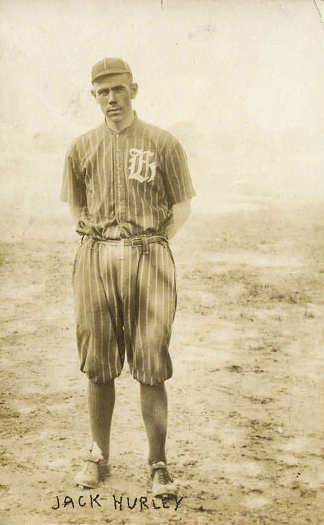
John L. "Jack" Hurley, Hagerstown
Terriers Manager,
1917 BRL Batting Champion © Daniel Yaw of Tampa, FL/www.vintageball.com
The Managers on the Field
Martinsburg’s veteran Player/ Manager, William “Country”
Morris headlined the list of managers who led their
clubs during the 1917 season, marking his third season
at the helm of the Mountaineers. Eddie Hooper, started
the season as the Chambersburg player/manager, until he
was replaced by Brook Crist, after the franchise was
moved to Cumberland, MD. Hagerstown brought new life
into their club with the addition of popular
player/manager, Jack Hurley. Hurley also received help
from veteran outfielder, Charlie Dysert, who served as
interim manager for a few games during the season, while
Hurley was out.Former Major Leaguer, Tom Crooke, took
over as Manager of the Frederick club, who had renamed
themselves, the Hustlers, after their 1915 League
Championship moniker. Joe Ward was hired to manager
Gettysburg, and stayed until the last two weeks of the
season, when he left the club, and was replaced by
pitcher Johnny Mumford to finish the season.
Hagerstown Wins Controversial League Pennant Despite all the controversy the league faced off the field, their was baseball still being played on the field. When the dust settled on September 4, the Hagerstown Terriers finished with a 61-36 record to earn their first league championship. The title was a little tainted, by the frustrated Martinsburg club, who finished second (59-40), for the third year in a row. Gettysburg, despite all their financial woes, still had a respectable showing, finishing third, 6 ˝ games back from the Terriers. While Hanover and Frederick battled for fourth place, poor Cumberland couldn’t get out of the cellar, finishing 26 game back from the leaders.
The Martinsburg club protested Hagerstown’s league
championship, accusing the Terriers of using an
ineligible player. After review from President Jamison,
the allegations were ruled unsubstantiated, and
Hagerstown came away with the 1917 league pennant.
Future Member of the Baseball Hall of Fame
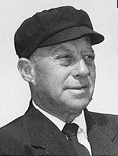
Bill McGowan, Hall of Fame umpire
Umpired the Class D, Blue Ridge League in 1917 © Baseball Hall of Fame Library, Cooperstown, NY
Despite the challenges during the season, several
positives came out 1917. The Blue Ridge League did have
one Baseball Hall of Fame inductee r from this season,
but it was not a player. Jamison brought in an 21-year
old umpire from Wilmington, DE, named William “Bill”
McGowan, who earned many accolades for his unbiased and
professional work behind the plate. McGowan would later
serve 29 years as an umpire in the Major League, until
his death in 1954. Bill McGowan McGowan was inducted in
the Baseball Hall of Fame in 1992.
Prospects 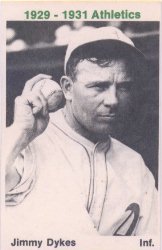
Jimmy Dykes, Gettysburg Ponies, 2nd
Baseman
© Philadelphia Athletics Historical Society, Philadelphia, PA.
Gettysburg’s 17-year old infielder Jimmy Dykes would
become a standout infielder in the Major Leagues, and
had the distinction of replacing the legendary Connie
Mack as the Manager of the Philadelphia Athletics in
1951. Hagerstown first baseman/manager, Jack Hurley led
the league with an impressive .385 batting average, and
Martinsburg’s Johnny Bates set a new league mark with 15
home runs. Martinsburg switch-hitting first baseman,
Luzerne “Lu” Blue, established a record that took 80
years to match, when he hit grand slams from both sides
of the plate in one game vs Frederick. Blue would later
have a successful major league career with the Detroit
Tigers and the St. Louis Browns.
Despite winning only 46 games, the Frederick Hustlers did have several highlights, including 37-year old pitcher, Wick Winslow (21-12), who established a club mark with 21 wins, completing all 30 games he started, while tossing eight shutouts, and hitting a team-high eight home runs. Teammate Clyde Barnhart, who was playing 1917 Frederick Hustlers his third season with Frederick, was signed by the Birmingham club at the end of the season, en route to a ten-year career with the Pittsburgh Pirates (1920-29). 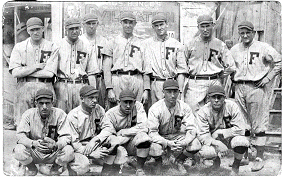
1917 Frederick Hustlers
Top row (from left) - Wick Winslow, Charlie Maurer, Bill King, Eddie Hook, Jake ZInell, Tom Crooke (mgr), Bill Mortimer Bottom row (from left) - John Doherty, Bill Phoenix, "Monk" Walter, Clyde Barnhart, Ralph Frasier. © Shirley Perez, Waynesboro, PA
The end of the season marked the final demise of the
Gettysburg franchise. Hanover also dropped out after the
season, citing financial reasons. Though the Hanover
club did return to the league in 1920, the Gettysburg
franchise never returned to the Blue Ridge League.
Every club in the circuit lost money during this season, but the four remaining clubs stayed resilient after completing their third full season in the National Association of Professional Baseball Leagues, under the leadership of President Jamison.
+++++++++++++++++++
End Chapter Three
Newspaper clippings credited to
www.newspaperarchives.com and
|
© Boys of the Blue Ridge, 2026.
Website Hosting by 270net Technologies in Frederick, Maryland

